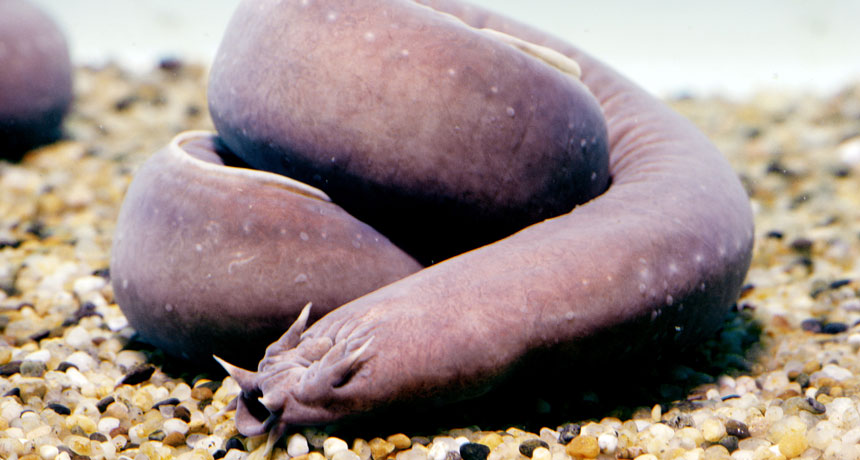Unusually loose skin helps hagfish survive shark attacks

NEW ORLEANS, La. – Skin that mostly hangs loose around hagfishes proves handy for living through a shark attack or wriggling through a crevice.
The skin on hagfishes’ long, sausage-style bodies is attached in a line down the center of their backs and in flexible connections where glands release slime, explained Douglas Fudge of Chapman University in Orange, Calif. This floating skin easily slip-slides in various directions. A shark tooth can puncture the skin but not stab into the muscle below. And a shark attack is just one of the crises when loose skin can help, Fudge reported January 5 at the annual meeting of the Society for Integrative and Comparative Biology.
Hagfishes can fend off an attacking shark by quick-releasing a cloud of slime. Yet video of such events shows that a shark can land a bite before getting slimed. To figure out how hagfishes might survive such wounds, Fudge and colleagues used an indoor guillotine to drop a large mako shark tooth into hagfish carcasses. With the skin in its naturally loose state, the tooth readily punched through skin but slipped away from stabbing into the body of either the Atlantic (Myxine glutinosa) or Pacific (Eptatretus stoutii) hagfish species.
But when the researchers glued the skin firmly to the hagfish muscle so the skin couldn’t slip, the tooth typically plunged into inner tissue. For comparison, the researchers tested lampreys, which are similarly tube-shaped but with skin well-fastened to their innards. When the guillotine dropped on them, the tooth often stabbed directly into flesh.
The finding makes sense to Theodore Uyeno of Valdosta State University in Georgia, whose laboratory work suggests how loose skin might work in minimizing damage from shark bites. He and colleagues have tested how hard it is to puncture swatches of skin from both the Atlantic and Pacific species. As is true for many other materials, punching through a swatch of hagfish skin held taut didn’t take as long as punching through skin patches allowed to go slack, he said in a January 5 presentation at the meeting. Even a slight delay when a sharp point bears down on baggy skin might allow the hagfish to start dodging and sliming.
But Michelle Graham, who studies locomotion in flying snakes at Virginia Tech, wondered if puncture wounds would be a drawback to such a defense. A hagfish that avoids a deep stab could still lose blood from the skin puncture. That’s true, said Fudge, but the loss doesn’t seem to be great. Hagfish have unusually low blood pressure, and video of real attacks doesn’t show great gushes.
Hagfish blood also plays a part in another benefit of loose skin — an unusual ability to wiggle through cracks, Fudge reported in a second talk at the meeting. One of his students built an adjustable crevice and found that both Atlantic and Pacific hagfishes can contort themselves through slits only half as wide as their original body diameter. Videos show skin bulging out to the rear as the strong pinch of the opening forces blood backward.
The cavity just under a hagfish’s skin can hold roughly a third of its blood. Forcing that reservoir backward can help shrink the body diameter. Fortunately the inner body tapers at the end, Fudge said. So as blood builds up, “they don’t explode.”